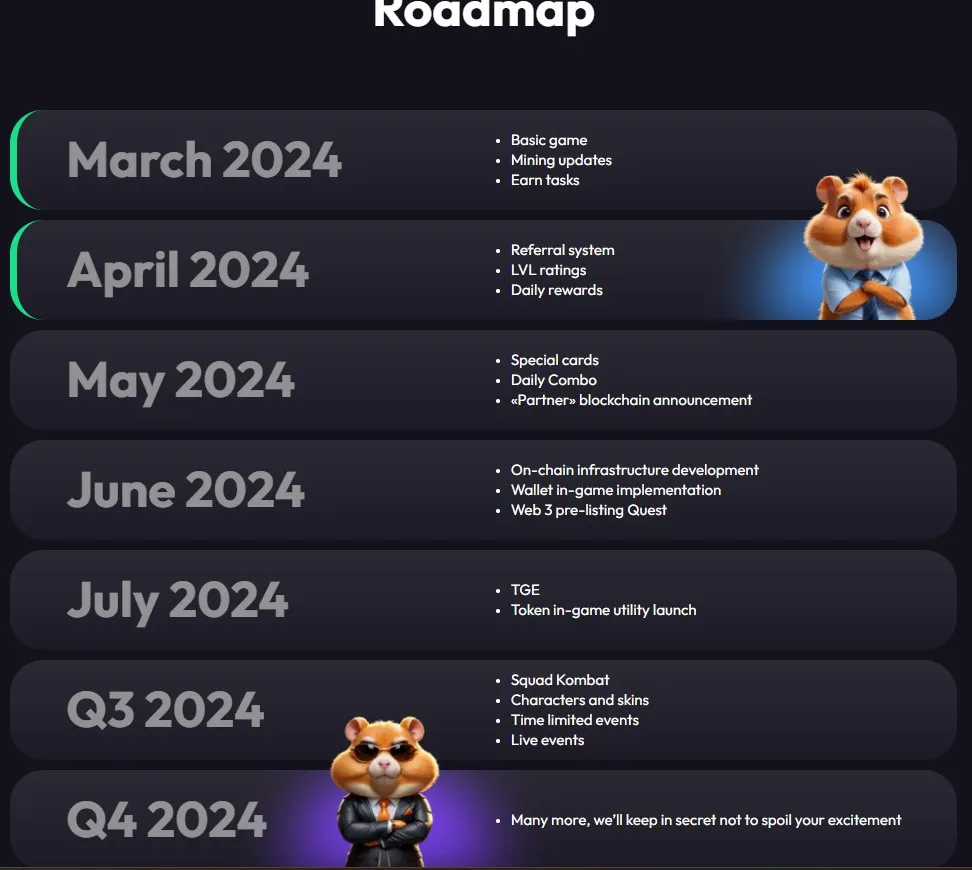Telegram clicker game Hamster Kombat has just rolled out an ambitious roadmap that stretches into 2025. The dev team behind the title is aiming to incorporate NFTs as in-game assets, build a Web3 gaming platform, and create a unique token economy. In doing so, their goal is to not only redefine the future of the game but also to impact the world of blockchain gaming.
Development Roadmap
Hamster Kombat’s plan begins with the inclusion of NFTs as assets within the game. This will change how players interact with the game through ownership, trading, and monetization of items that players earn or buy in the game. The team is also building an ad network to generate more revenue for the project.

The roadmap also indicates that gameplay may become more competitive with a clan championship in the works. This NFT expansion, along with the competitive potential of the game, could attract a whole new group of players and collectors to the game.
The development roadmap’s most exciting aspect might be the formation of a comprehensive Web3 gaming. The team behind Hamster Kombat sees it as far more than an idle clicker game. They picture it as the cornerstone of something bigger—a blend of the user-friendly experiences of Web2 and the decentralized, transparent nature of Web3.
Token Economy
The token economy, and especially the strategy of buybacks, will be crucial to Hamster Kombat’s future. The Hamster Kombat team plans to use revenue from its newly established advertising network to buy back and burn the in-game HMSTR token. By reducing the total supply of tokens that are in circulation, the team hopes to create a scarcity that will drive up the token’s market value.
Speculation is already afoot regarding future demand for the new HMSTR token with its total supply of 100 billion tokens. Some industry experts forecast an optimistic future for the token, while others express reservations. In any case, the team’s commitment to creating a token economy that is both sustainable and engaging is clear.
Airdrop Controversy and Market Reaction
The much-anticipated airdrop of HMSTR tokens took place recently, with the tokens being distributed to eligible users. However, the distribution event received mixed reactions. Of the 300 million total users who have played Hamster Kombat since March, only 131 million players qualified for the distribution, with about 2.3 million users having been excluded for suspected cheating. Despite the anticipation surrounding the event, many players expressed disappointment in the trivial amount of rewards they received.
The market reacted quickly to the airdrop, with the price of HMSTR falling significantly on the day of its release. According to CoinGecko, it dropped 41% from an initial price of $0.012, while CoinMarketCap reported a 25% decline from an initial price of $0.009. Furthermore, a very large fraction of all wallets holding HMSTR (nearly 18% of the circulating supply) is held in a Binance hot wallet.
Despite facing this setback, Hamster Kombat is planning for a second season. The studio also aims to incorporate additional games into its ecosystem and revitalize interest in its projects, all with the goal of stabilizing token price in the long run.

Future Outlook
The Hamster Kombat roadmap includes several important milestones that could help define the future of gaming on Telegram. The planned rollout of an NFT marketplace, along with the expansion of the game’s ecosystem, points to a vision that embraces not just gameplay but also the creation of a player-driven economy.
Hamster Kombat’s success is tied to the blockchain industry’s development and the steadily increasing popularity of Web3 gaming platforms. Because of its open networks and decentralized nature, Web3 offers players a gaming experience that’s far more transparent and community-driven than what’s currently available—standards that could, in time, be adopted across the industry.
As one of the first pioneering games on Telegram, all eyes are on Hamster Kombat to see how it will operate within this new ecosystem. It might just serve as a model for any future blockchain games that aim to balance gameplay, tokenomics, and player engagement.
Over the next few months and years, we’ll see whether Hamster Kombat’s strategies—around NFTs, token buybacks, and community-driven experiences—actually result in the pricing successes that Hamster fans everywhere desire. For now, the game’s designs make it a likely player in the Web3 space.
Editor’s note: This article was written with the assistance of AI. Edited and fact-checked by Owen Skelton.







Leave a Reply